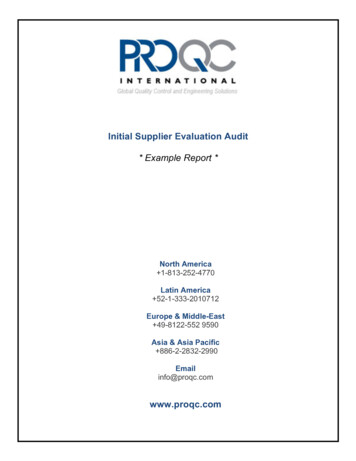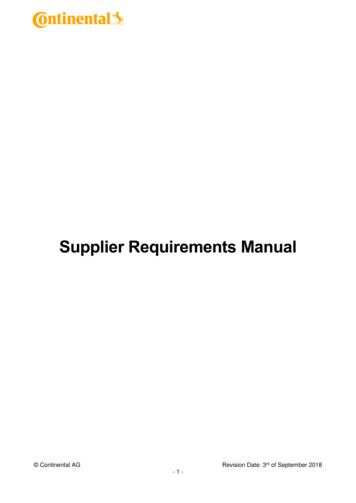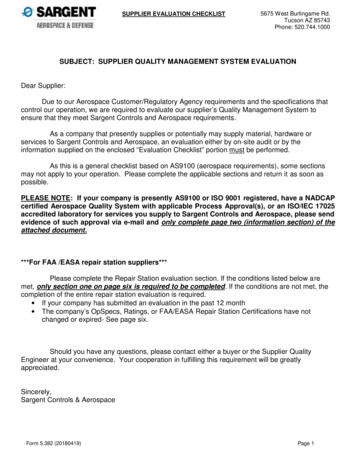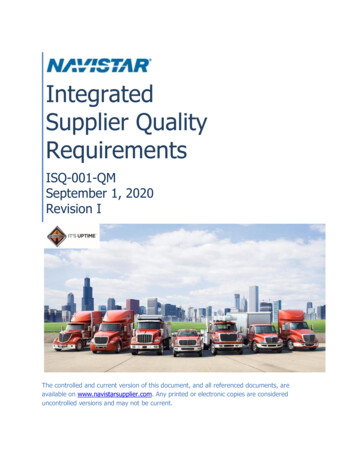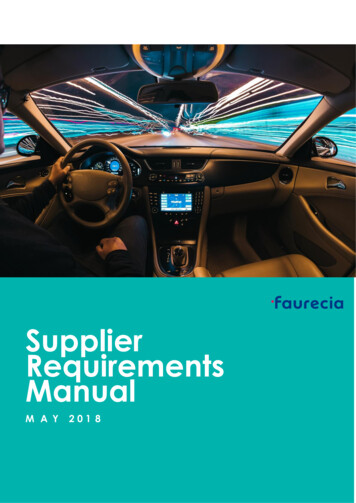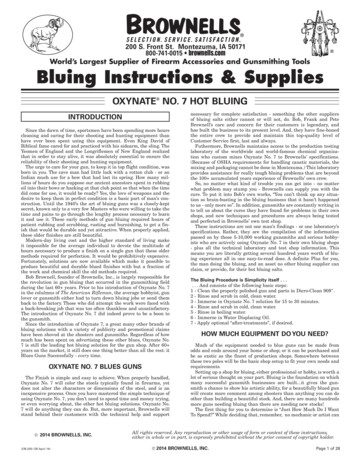
Transcription
200 S. Front St. Montezuma, IA 50171800-741-0015 brownells.comWorld’s Largest Supplier of Firearm Accessories and Gunsmithing ToolsBluing Instructions & SuppliesOXYNATE NO. 7 HOT BLUINGINTRODUCTIONSince the dawn of time, sportsmen have been spending more hourscleaning and caring for their shooting and hunting equipment thanhave ever been spent using this equipment. Even King David ofBiblical fame cared for and practiced with his sidearm, the sling. TheYeomen of England and the Longriflemen of New England realizedthat in order to stay alive, it was absolutely essential to ensure thereliability of their shooting and hunting equipment.The urge to care for your gun, to keep it in top flight condition, wasborn in you. The cave man had little luck with a rotten club - or anIndian much use for a bow that had lost its spring. How many millions of hours do you suppose our ancient ancestors spent in rubbingoil into their bows or hacking at that club point so that when the timedid come for use, it would be ready? Yes, the love of weapons and thedesire to keep them in perfect condition is a basic part of man’s construction. Until the 1940’s the art of bluing guns was a closely-keptsecret, known only to a very few Masters who were willing to take thetime and pains to go through the lengthy process necessary to learnit and use it. These early methods of gun bluing required hours ofpatient rubbing and scrubbing, rusting and burnishing, to get a finish that would be durable and yet attractive. When properly applied,these older finishes are still beautiful.Modern-day living cost and the higher standard of living makeit impossible for the average individual to devote the multitude ofhours necessary to produce a finish on a single gun that these oldermethods required for perfection. It would be prohibitively expensive.Fortunately, solutions are now available which make it possible toproduce beautiful and durable blued finishes with but a fraction ofthe work and chemical skill the old methods required.Bob Brownell, founder of Brownells, Inc., is largely responsible forthe revolution in gun bluing that occurred in the gunsmithing fieldduring the last 60 years. Prior to his introduction of Oxynate No. 7in the colulmns of The American Rifleman, the average hobbyist, gunlover or gunsmith either had to turn down bluing jobs or send themback to the factory. Those who did attempt the work were faced witha back-breaking job that was too often thankless and unsatisfactory.The introduction of Oxynate No. 7 did indeed prove to be a boon tothe gunsmith.Since the introduction of Oxynate 7, a great many other brands ofbluing solutions with a variety of publicity and promotional claimshave been shoved at the shooters and gunsmiths. Regardless of howmuch has been spent on advertising these other blues, Oxynate No.7 is still the leading hot bluing solution for the gun shop. After 60 years on the market, it still does one thing better than all the rest: itBlues Guns Successfully - every time.OXYNATE NO. 7 BLUES GUNSThe Finish is simple and easy to achieve. When properly handled,Oxynate No. 7 will color the steels typically found in firearms, yetdoes not alter the characters or dimensions of the steel, and is aninexpensive process. Once you have mastered the simple technique ofusing Oxynate No. 7, you don’t need to spend time and money trying,or even worrying about, the other hot bluing solutions. Oxynate No.7 will do anything they can do. But, more important, Brownells willstand behind their customers with the technical help and support 2014 BROWNELLS, INC.076-200-135 April 14rnecessary for complete satisfaction - something the other suppliersof bluing salts either cannot or will not, do. Bob, Frank and PeteBrownell’s care and concern for their customers is legendary, andhas built the business to its present level. And, they have fine-honedthe entire crew to provide and maintain this top-quality level ofCustomer Service first, last and always.Futhermore, Brownells maintains access to the production testinglaboratory of the worldwide and world-famous chemical organization who custom mixes Oxynate No. 7 to Brownells’ specifications.(Because of OSHA requirements for handling caustic materials, themixing and packaging cannot be done in Montezuma.) This laboratoryprovides assistance for really tough bluing problems that are beyondthe 100 accumulated years experience of Brownells’ own crew.So, no matter what kind of trouble you can get into - no matterwhat problem may stump you - Brownells can supply you with thecure. To put it into Bob’s own works, “You can’t think up any situation so brain-busting in the bluing business that it hasn’t happenedto us - only more so”. In addition, gunsmiths are constantly writing into tell us about the cures they have found for problems in their ownshops, and new techniques and procedures are always being testedand perfected in Brownells’ own test shop.These instructions are not one man’s findings - or one laboratory’sspecifications. Rather, they are the compilation of the informationpassed on by those 5-10,000 working gunsmiths and serious hobbyists who are actively using Oxynate No. 7 in their own bluing shops- plus all the technical laboratory and test shop information. Thismeans you are literally getting several hundred years worth of bluing experience all in one easy-to-read dose. A definite Plus for you,the man doing the bluing, and an asset no other bluing supplier canclaim, or provide, for their hot bluing salts.The Bluing Procedure is Simplicity itself . . . . . And consists of the following basic steps:1 - Clean the properly polished gun and parts in Dicro-Clean 909 .2 - Rinse and scrub in cold, clean water.3 - Immerse in Oxynate No. 7 solution for 15 to 30 minutes.4 - Rinse and scrub in cold, clean water.5 - Rinse in boiling water.6 - Immerse in Water Displacing Oil.7 - Apply optional “after-treatments”, if desired.HOW MUCH EQUIPMENT DO YOU NEED?Much of the equipment needed to blue guns can be made fromodds and ends around your home or shop; or it can be purchased andbe as exotic as the finest of production shops. Somewhere betweenthese two poles will be the basic shop setup to fit your own needs andrequirements.Setting up a shop for bluing, either professional or hobby, is worth alot of serious thought on your part. Bluing is the foundation on whichmany successful gunsmith businesses are built.it gives the gunsmith a chance to show his artistic ability, for a beautifully blued gunwill create more comment among shooters than anything you can doother than building a beautiful stock. And, there are many hundredsmore guns needing bluing than there are needing new stocks!The first thing for you to determine is “Just How Much Do I WantTo Spend?” While deciding that, remember, no mechanic or artist canAll rights reserved. Any reproduction or other usage of form or content of these instructions,either in whole or in part, is expressly prohibited without the prior consent of copyright holder. 2014 BROWNELLS, INC.Page 1 of 28
do good work with inferior tools. On the other hand, don’t go in overyour head. Maybe the shooters in your locality are going to need a lotof education before they start bringing in guns in sufficient quantityfor you to justify spending a lot of money at the start.Next, you need to decide, “How Many Guns Am I Going To Blue”.One or two guns - a dozen or so - or do you plan to make the work aprofitable hobby or full-time occupation? The answers to these questions are important, for from them you can then determine just howmuch to spend and what items you should consider buying whenstarting up.Regardless of what your answer is (if you are just starting up)do not plan on buying all your equipment in one fell swoop. Get thebasic supplies first and get the BEST. Then, as time goes on, add justthose items you HAVE to have and again, get the best. In this way,you will eventually - and affordably - have the best equipped shop inyour locality.SETTING UP THE BLUING ROOMYou want to consider the location of your bluing room quite seriously, for once the word is out that you do beautiful bluing, we aretold you will find people beating a path to your door - at least this iswhat we are told happens, time after time. It is true that guns havebeen blued on back porches, in garages, tool sheds, privies, barns andback rooms, but for ease of operation “down the road”, plan seriouslynow, even tho’ you are just going to use two tanks at start-up. Thatway, when it grows into a business for you, you will not have a lot ofexpensive rebuilding to do. So, consider the following:A good floor plan for the five-or-six tank setup is a deep-side “U”.The Cleaning Solution and Cold Water Rinse Tank are on the leftof the “U”, the Bluing Solution Tank is across the bottom, and theAfter-bluing Cold Water Rinse Tank and the Hot Water Rinse Tanka separate area away from the heated tanks. Our setup works clockwise, with the Cleaning Solution Tank as the first tank on the left leg.The rotation direction is totally your personal preference. With thislayout, one individual can easily handle a large volume of work witha minimum of movement.In a 5-tank setup, the tanks are as follows:1) Dicro-Clean 909 Cleaning Solution Tank2) Flowing Cold Water Rinse Tank (used both for rinsing afterCleaning Solution and after Bluing Solution)3) Oxynate No. 7 Bluing Solution Tank4) Hot Water Rinse Tank5) Water Displacing Oil TankIn a 6-tank setup, the tanks are as follows:1) Dicro-Clean 909 Cleaning Solution Tank2) Flowing Cold Water Rinse Tank3) Oxynate No. 7 Bluing Solution Tank4) After-Bluing Flowing Cold Water Rinse Tank5) Hot Water Rinse Tank6) Water Displacing Oil TankSTEAM & VENTILATION: Be sure your bluing room is sealed off from- or entirely separate from - your shop area. There are three reasonsfor this. First, the steam from the Bluing Tank is very corrosive, andin a very short time every tool you own will be rusty if your Shop andBluing Room are together. (This steam has even rusted tail stockssolid to lathe “ways” before the shop owner caught it!) Secondly, youmust keep people who do not realize the hazards involved workingwith bluing salts, completely OUT of your bluing area. It is particularly vital that you keep all children and pets out, for involuntarymassive contact with the bluing salts could prove fatal; at the veryleast, it can involve severe and dangerous caustic burns. Be particularly insistent on keeping people out of your bluing room. Thirdly,you must have proper and adequate ventilation for the bluing room.Air should come in through a vent or screened panel about 18" abovefloor level behind the operator, pass across the bluing tank to besucked out above and/or behind the bluing tank and exhausted to theatmosphere. Be sure you have adequate “make-up” air from outdoorsfor the fan to work properly. Do not use galvanized metal anywherein the bluing room, particularly in hood construction over the tankor framing of the fan. Do not use aluminum-bladed fans, duct work,window panels, etc. Be sure you are not ducting fumes onto an aluminum-sided building or where it will settle on any aluminum . . .simply eats it up, pronto. You must move a lot of air through the bluing room, so use a good exhaust fan, like a furnace, squirrel-cage fan(all steel only) . . . the bathroom or kitchen kind won’t handle it. Don’tworry about heat loss with the vent system. Keeping warm has neverbeen a problem when bluing! The caustic fumes are a real problem,however, and you must get them out.Page 2 of 28WATER: Running water in the bluing room is a fine asset if available.If you cannot hard-pipe it in, run a garden hose with a shut-off intothe bluing room on bluing days.LIGHTING: Good, bright lights are a necessity, and you must haveone, good, incandescent light bulb directly over the After-Bluing ColdWater Rinse Tank.SHELVES: A shelf or two along the walls is also mighty handy!DUCK BOARDS: If much bluing is to be done, a wood slat riser orraised duck board on the floor will increase operator comfort andsafety, and help prevent slipping.EQUIPPING THE BLUING ROOMTo set up your bluing operation on an efficient and profitable basis,you will want to consider the equipment and supplies listed below. Wehave covered each item in as complete detail as possible. As you blue,you will undoubtedly refer back to this section for bits and pieces ofspecific information listed under each piece of equipment.TANKS: The following solutions require tanks: 909 CleaningSolution; Cold Water Rinse; Bluing Solution; Hot Water Rinse andWater Displacing Oil.Two tanks are the “bare-bones” minimum you can get by with. Thisis for the man who wants to blue an occasional gun. One tank is usedfor the Oxynate No. 7; the second tank will be used for everything elseexcept the Water Displacing Oil. This includes: 1) the 909 CleaningSolution; 2) the two Cold Water Rinses, and 3) the Hot Water Rinse.To make the system work with only 2 tanks, you have to do somedumping and refilling during the bluing cycle. 1) After the gun iscleaned in the 909 Cleaning Solution Tank, the Cleaning Solution isimmediately dumped. 2) The Tank is filled with clean, cold water intowhich the gun is plunged to be scrubbed and rinsed before, 3) It istransferred to the Bluing Tank, which must be at operating temperature. 4) While the gun is bluing, the Tank is dumped and refilled withfresh, clean, cold water in which the gun is rinsed after it comes outof the Bluing Tank. 5) The water in the Tank is again changed to hotwater which is brought to a boil, and the gun is soaked in the boilingwater for 10 to 30 minutes. 6) The excess water is shaken off the gunand it is liberally covered with Water Displacing Oil (soaking in atank of Water Displacing Oil is preferred).The use of additional tanks not only increases your efficiency, butalso cuts down on operator time, which lets you turn out more gunsfor less cost per gun. Four tanks - 1) 909 Cleaning Solution, 2) ColdWater Rinse, 3) Bluing Solution, and 4) Boiling Water Rinse - makefor a much better operation than the two tank method. The additionof two more tanks for a total of six, - one for a separate, After-BluingCold Water Rinse (to prevent cross-contamination from the cleaningsolution’s residue on the freshly blued gun), and the other for WaterDisplacing Oil - makes an ideal and very efficient setup . . . and, is ourpersonal choice for the number of tanks to use.Tanks can be made of either black iron, stainless steel or gel-coatedfiberglass, depending upon which solutions you are going to put intothem.Black Iron: Suitable for all solutions used in the bluing operation.(Note: All seams on the metal tanks must be welded; they must neverbe brazed, because it takes less than .001 oz. of free copper per gallonof Bluing Solution to “kill” a Bluing Solution.)Stainless Steel: Suitable for all solutions used in the bluing operation, except for bluing salts, because there is the possibility of electrolytic action between the bluing salts, the stainless steel and thegun metal. When this happens, it results in gray streaks and/or little“silvery” specks in the finished blue job. These tanks are superb forall other operations, but are not necessary.Gel-Coated Fiberglass: Suitable for all of the non-heated solutions;the Cold Water Rinse Tanks and the Water Displacing Oil Tank. Alsoideal for other chemicals used in the Bluing Room - Acid for etching,Rust Remover, Pro-Sheen , or Pro-Tek .The average pistol tank should be 6" wide, 6" deep and at least 16"long. Common black iron or mild steel bread pans are satisfactory forpistol work, providing the pan is large enough. (These are the “oldfashioned” bread pans, and can sometimes be found at householdsales. Modern bread pans are usually aluminum or teflon-coated aluminum, which are rapidly destroyed by the Bluing Solution, besidesdestroying the Bluing Solution.) Or, you can use the “Half Tank”shown in the catalog section at the end of these instructions. 2014 BROWNELLS, INC.076-200-135 April 14r
Rifle tanks should be 6" wide, 6" deep and at least 40" long (44" ifyou blue some of the muzzleloading barrels).We do not recommend zinc-plated (galvanized) tanks; however,they are occasionally used for rinse tanks. It can be done, but thereis a strong possibility of trouble. Due to the composition of your localwater, there is a strong chance that there will be an electrolytic actionsetup when the steel gun parts are placed in water in a galvanizedtank. This results in a mild transfer of zinc from the tank to the gun,and that results in white specks in the final bluing job.Ideally, the Cold Water Rinse Tank should be set up as a “topoverflow” tank to make it self-cleaning and prevent redepositingresidue from the cleaning operation - or the after-bluing rinse - onthe guns. By keeping the surface cleaned off, the scrubbed gun orpart is brought back up through a clean water surface and comes outclean instead of being recoated with the junk just scrubbed off it. Thissimple modification will solve most of your contamination problemsand thus, your speckling and spotting problems, too.The top-overflow system can be accomplished in several ways; wehave given two suggestions to get your thinking started.1) Set the tank in an oversized, outside container that is connectedto a drain line. Connect a garden hose to a section of rigid plasticpipe or hose with several holes drilled in it, and lay it in the bottomof the tank, connecting the other end to the cold water faucet. As thewater flows through the pipe and out the holes, clean, fresh wateris brought into the bottom of the tank forcing the old water upwardover the sides of the tank, into the overflow container and down thedrain. In doing so, all residue from the 909 Cleaning Solution Bath orthe Bluing Solution Bath is constantly being flushed out of the tank,assuring a continuous and adequate supply of clean, fresh water forrinsing. Set the tank so the water flows evenly over the top edge - allaround the top edge - to prevent “dead-spots” of old water in the tank.Use a medium water flow.2) Using one of the Black Iron or Fiberglass Tanks, drill a series ofholes along one end. Bring fresh water into the tank at the oppositeend, and, using a medium water flow, keep the surface of the rinseTank flushed clean. It is important to have a constantly replenishedsupply of fresh water for this method to work.the tank to keep the tanks’ surface flushed clean.Finally, if none of these methods will work for you, be sure to dumpand refill the Cold Water Rinse Tank frequently to remove the junkthat floats to the surface and stays there to possibly discolor or streakyour bluing.HEAT SOURCE: You will need a heat source for the 909 CleaningSolution Tank, and Bluing Solution Tank and the Hot Water RinseTank. (In our discussion, we will be talking about Pipe burners, altho’alternate heat sources can be used.)The Bluing Tank Pipe Burners, with a 42,000 BTU per hour input,have been specifically designed and built for us by one of the country’sleading industrial gas burner manufacturers to heat and operate a 6"x 6" x 40" Black Iron Tank containing 4 gallons of working OxynateNo. 7 Bluing Solution. We had these special pipe burners madebecause the heat source for the Bluing Solution Tank is quite critical.It must be able to bring the volume of the Bluing solution up to theoperating temperature fairly rapidly, yet must be adjustable down tothe proper “carrying” flame for correct maintenance and control ofthe Bluing Solution’s operating temperature. (See the specific instructions on this step later.) The Bluing Solution Tank Pipe Burners areshown in the catalog section at the end of these instructions. They aredefinitely recommended and worthy of your serious consideration.The Hot Water Tank Pipe Burners, designed and made for us bythe same people who make the Bluing Tank Pipe Burners, are specially-sized 25,000 BTU per hour input gas burners to efficiently heatthe 909 Cleaning Solution Tank and the Hot Water Rinse Tank. Forthe occasional bluing operation, these two tanks can be heated overheavy-duty hot plates, gas ring burners or other heavy-duty, highoutput heat sources.Half Tank Burners, designed to be used with the pistol-length HalfTanks. Gas input is 10,000 BTU per hour. Do not attempt to use theseshort burners to heat the full-length tanks.Natural Gas and LP Gas are the two types of gas used for fuel tooperate the Pipe Burners. There are several specifications for eachthat you must be aware of - specifically: operating pressure, gas linepipe diameter sizes relative to distance to the regulator, and orificesizes.TECHNICAL SPECIFICATIONS FOR PIPE BURNERSNATURAL GAS SPECIFICATIONSPressure at Burner: 4 inches to 6 inches of water columnOrifice Size on Bluing Solution Tank Pipe Burners: #32 drillOrifice Size on Hot Water Tank Pipe Burners: #43 drillOrifice Size on Half Tank Pipe Burners: #52 drillLP GAS SPECIFICATIONSPressure at Burner: 11 inches of water columnOrifice Size on Bluing Solution Tank Pipe Burners: #51 drillOrifice Size on Hot Water Tank Pipe Burners: #53 drillOrifice Size on Half Tank Pipe Burners: #63 drillSUPPLY PIPE DIAMETERS REQUIREDSUPPLY PIPE DIAMETERS REQUIREDBLUING TANK PIPE BURNERS USING NATURAL GASNo. ofDISTANCE TO REGULATORBURNERS10'20'30'40'50'1 3 3 3 3 1 Burner2" Pipe4" Pipe4" Pipe4" Pipe4" Pipe3 3 3 2 Burners1" Pipe1" Pipe4" Pipe4" Pipe4" Pipe3 3 Burners1" Pipe1" Pipe1" Pipe1" Pipe4" Pipe4 Burners1" Pipe1" Pipe1" Pipe 11 4" Pipe 11 4" Pipe5 Burners1" Pipe1" Pipe 11 4" Pipe 11 4" Pipe 11 4" PipeBLUING TANK PIPE BURNERS USING LP GASNo. ofDISTANCE TO REGULATORBURNERS10'20'30'40'1 1 1 1 1 Burner2" Pipe2" Pipe2" Pipe2" Pipe1 3 3 3 2 Burners2" Pipe4" Pipe4" Pipe4" Pipe3 3 3 3 Burners1" Pipe4" Pipe4" Pipe4" Pipe3 3 4 Burners1" Pipe1" Pipe4" Pipe4" Pipe3 5 Burners1" Pipe1" Pipe1" Pipe4" PipeHOT WATER TANK PIPE BURNERS USING NATURAL GASNo. ofDISTANCE TO REGULATORBURNERS10'20'30'40'50'3 3 3 3 3 1 Burner8" Pipe8" Pipe8" Pipe8" Pipe8" Pipe3 1 1 1 1 2 Burners8" Pipe2" Pipe2" Pipe2" Pipe2" Pipe1 1 3 3 3 3 Burners2" Pipe2" Pipe4" Pipe4" Pipe4" Pipe1 3 3 3 3 4 Burners2" Pipe4" Pipe4" Pipe4" Pipe4" Pipe3 3 3 3 3 5 Burners4" Pipe4" Pipe4" Pipe4" Pipe4" PipeHOT WATER TANK PIPE BURNERS USING LP GASNo. ofDISTANCE TO REGULATORBURNERS10'20'30'40'50'3 3 3 3 3 1 Burner8" Pipe8" Pipe8" Pipe8" Pipe8" Pipe3 3 3 1 1 2 Burners8" Pipe8" Pipe8" Pipe2" Pipe2" Pipe3 1 1 1 1 3 Burners8" Pipe2" Pipe2" Pipe2" Pipe2" Pipe1 1 1 3 3 4 Burners2" Pipe2" Pipe2" Pipe4" Pipe4" Pipe1 1 3 3 3 5 Burners2" Pipe2" Pipe4" Pipe4" Pipe4" PipeHALF TANK PIPE BURNERS USING NATURAL GASNo. ofDISTANCE TO REGULATORBURNERS10'20'30'40'50'3 3 3 3 3 1 Burner8" Pipe8" Pipe8" Pipe8" Pipe8" Pipe3 3 3 3 3 2 Burners8" Pipe8" Pipe8" Pipe8" Pipe8" Pipe3 3 3 3 3 3 Burners8" Pipe8" Pipe8" Pipe8" Pipe8" Pipe3 3 1 1 1 4 Burners8" Pipe8" Pipe2" Pipe2" Pipe2" Pipe3 1 1 1 1 5 Burners8" Pipe2" Pipe2" Pipe2" Pipe2" PipeNo. ofBURNERS1 Burner2 Burners3 Burners4 Burners5 Burners076-200-135 April 14r 2014 BROWNELLS, INC.HALF TANK PIPE BURNERS USING LP GASDISTANCE TO REGULATOR10'20'30'40'3 3 3 3 8" Pipe8" Pipe8" Pipe8" Pipe3 3 3 3 8" Pipe8" Pipe8" Pipe8" Pipe3 3 3 3 8" Pipe8" Pipe8" Pipe8" Pipe3 3 3 3 8" Pipe8" Pipe8" Pipe8" Pipe3 3 3 1 8" Pipe8" Pipe8" Pipe2" Pipe50'" Pipe3 4" Pipe1" Pipe1" Pipe1" Pipe3 450'" Pipe3 8" Pipe3 8" Pipe3 8" Pipe1 2" Pipe3 8Page 3 of 28
The commercial gas heating equipment manufacturer who makesthe Pipe Burners for us recommends that the tip of the white cone ofthe flame should just be “brushing” the bottom of the bluing Tank fortotal combustion of the gas being burned and the most uniform heatto the bottom of the tank. This usually puts the Pipe Burner about 2"below the bottom of the tank, but we strongly recommend you use anadjustable mounting system so you can adjust the burner up or downonce it is in actual operation.All gas pipe used inside the Bluing Room must be black iron pipe.Copper pipe is attacked by the caustic steam put off by the boilingBluing Solution, and must not be used inside the Bluing Room.PARTS BASKETS: You will want two or more Small Parts Baskets. Werecommend lining at least one with black iron screen wire to use forthe multitude of small pins, screws and parts.THERMOMETER: A good thermometer is your single most importantworking tool when operating a Bluing Solution. Glass thermometersshould not be used. They break easily, and the mercury or alcohol inthem will contaminate the bath, killing its ability to blue. Cookingthermometers should not be used. They are not designed to withstandthe Bluing Solution, and frequently the caustic Bluing Solution willseep into the quill (stem) of the thermometer and destroy it. Or, theyare alloy or aluminum which dissolves in the Bluing Solution, ruining it. Use only thermometers which are specifically constructed towithstand the high caustic chemical action of bluing chemicals, thethermal shock of rapid heating and cooling, and a maximum temperature range of 350 F.We carry two different types of bluing thermometers: a traditionaltank-mounted model, and a large-dial, remote-reading, wall-mountedmodel. Each has advantages and disadvantages, so choose the versionthat fits your shop layout and budget best. You will need 2 - one forthe 909 Cleaning Solution Tank, and one for the Oxynate No. 7 BluingSolution Tank.When installing the tank-mount model in your bluing tank, youmust keep in mind three things. First, the thermometer shouldbe mounted in the center of the long side, halfway from each end.Second, it should be mounted so the quill has a 1" clearance from theback wall of the tank, and with 1" clearance between the tip of thequill (stem) and the bottom of the tank. There are several ingeniousways to mount the thermometer in this position, however, we like ametal clip like the one shown in the drawing below, to hold the thermometer securely in place.Third, closely examine the thermometer quill, and you will finda groove or cannelure between 2" to 3" from the tip. In order to getcorrect and accurate readings, this groove (which is the top of theRINSE TANK BRUSH: Made especially to do the best possible scrubjob on parts in the Cold Water Rinse Tank immediately following the909 Cleaning Solution Tank.BLACK IRON WIRE: Ideal for hanging parts and actions in the BluingTank, and an alternative to the “Z” Hooks described later for barrels.STAINLESS STEEL DIPPER: Used to add water and salts to theBluing Solution. Properly used, as described under “7), How To AddWater To The Bluing Solution”, page 8, it is a safe way to add waterto the Bluing Solution.SAFETY EQUIPMENT:Long-Sleeved, Cotton Shirt: Bluing Salts attacks wool, leather andskin. Wear cotton clothing, and other non-animal fiber clothing whenworking in your Bluing Room.Heavy-Duty, Gauntlet-Type Gloves: For all work around the BluingTank and Rinse Tanks. Get them large enough so you can removethem quickly when hands are sweaty.Neoprene Rubber Apron: Saves clothing and skin. Use it.Rubber Boots: With tops narrow enough to go under your pants legsto keep salts splash out of the boots.Full-Face Safety Shield or Goggles: Simple safety precaution whendealing with any chemical. We recommend the Full-Face SafetyShield.Filter Mask: Wear to prevent inhalation of the dust during mixup ofthe Bluing Solution and the caustic steam created during operation.Jar of Vinegar: Keep a wide mouth jar of vinegar close to your BluingSolution Tank to neutralize salts splashes on your skin. Immediatelyflood affected area with vinegar. Read and memorize warnings oncontainer of Oxynate No. 7 and throughout these instructions.CHEMICALS USED IN BLUINGThe chemicals listed below are divided into 2 categories: Those thatyou must have to blue and those that are optional, but extremelyuseful or helpful, or cure special problems that have arisen. We havemade each list alphabetical for your ease in referring back to thissection.CHEMICALS YOU MUST HAVEDICRO-CLEAN 909 CLEANER - A slightly aklaline detergent cleanerthat is formulated particularly for cleaning guns prior to bluing.Removes and puts into suspension all grease, dirt, crud. Strongenough to do the job right, yet when used according to the instructions, it is totally safe. Dispose of in accordance with all Federal,State, and local regulations. (Detailed Technical Information OnMixing And Using, page 6.)bi-metal strip inside the quill), must be covered by a minimum of 1"of Bluing Solution when the tank is operating. This necessitates anoverall tank depth of 4" to 41 2" as the absolute minimum you canwork with in your tank and still get accurate temperature readings.Failure to have this groove at least 1" under the surface of the BluingSolution will result in operating temperatures far in excess of theoptimal 292 F., and may well destroy the bath through heat-kill, withactual temperatures over 310 F.Mount the heat sensor for the remote-reading, wall-mountedthermometer in the same location in your Bluing Tank as describedabove, for the Bluing Tank mounted model. It should be mounted asnearly vertical as possible to give a reading through the entire depthof Bluing Solution. The tip should be 1" from the bottom and the sensor 1" from the back wall of the tank, and the entire sensor at least 1"below the surface of the Bluing Solution. The sensor must not touchthe back or bottom of the Bluing Tank. Wall-mount the dial in a convenient, easy-to-see spot above the Bluing Tank.STIRRING PADDLE: Get yourself a flat iron or mild steel “paddle” touse to stir the salts. Since you’ll use this paddle thousands of timesover the years to come, make it comfortable to use. An old service station tire iron is ideal. (Any plating must be removed.) You may alsowant to make a wider paddle, 3" - 4", to use when initially stirring thesalts and when there are no guns in the Bluing Solution.Page 4 of 28OXYNATE NO. 7 BLUING SALTS - For over 60 yea
the revolution in gun bluing that occurred in the gunsmithing field during the last 60 years. Prior to his introduction of Oxynate No. 7 in the colulmns of The American Rifleman, the average hobbyist, gun lover or gunsmith either had to turn down bluing jobs or send them back to th

